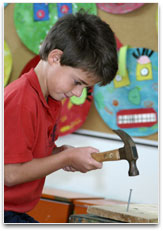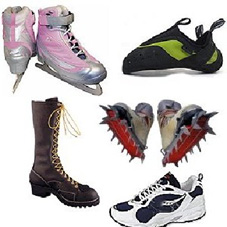This focus idea is explored through:
Contrasting student and scientific views
Student everyday experiences
 One of the most obvious effects of friction for students is that it can lead to the gradual wearing away of things; this can be seen in examples like the uneven soles of our shoes, balding bicycle tyres and the deliberate action of rubbing sandpaper on a surface. Experiences of trying to walk, roller skate or ski on slippery surfaces such as ice or snow promote an understanding that getting moving and/or changing direction are both difficult to do in environments where friction is reduced. Friction is frequently portrayed in the popular media as having a ‘bad’ effect and as something to be reduced or eliminated (for example by using friction reducing oils).
One of the most obvious effects of friction for students is that it can lead to the gradual wearing away of things; this can be seen in examples like the uneven soles of our shoes, balding bicycle tyres and the deliberate action of rubbing sandpaper on a surface. Experiences of trying to walk, roller skate or ski on slippery surfaces such as ice or snow promote an understanding that getting moving and/or changing direction are both difficult to do in environments where friction is reduced. Friction is frequently portrayed in the popular media as having a ‘bad’ effect and as something to be reduced or eliminated (for example by using friction reducing oils).
However, in students’ everyday lives, friction is not itself seen as involving forces and nor is it seen as being present when things are
not moving (for example, acting on a child who sits stationary halfway down a slide).
Friction is a confusing influence in our everyday experiences of motion because people are often not aware that friction involves forces.
For those who think that things move because they contain a force that keeps them moving, friction can be seen as responsible for gradually using up this force.
The alternative conception of forces being contained in objects is discussed in the focus idea
Pushes and pulls.
Scientific view
Scientists are not completely sure what causes friction; however it is thought to be caused by the interactions between the tiny bumps on surfaces as they rub against each other.
The bumps on each surface bend and exert a force on each other making it hard for the surfaces to slip over each other. The force on the moving surface is in the opposite direction and resists the motion.
As an example, the surface of a car tyre (the tread pattern) is designed to maximise the friction between the tyre and road surface over a wide range of weather conditions. When the friction is substantially reduced because of snow or ice on the road, the tyre slips and is unable to steer, drive or break the car.
Critical teaching ideas
- A useful model for explaining friction is the idea that all surfaces have tiny bumps.
- When two surfaces slide over one another the tiny bumps push on each other.
- Friction causes a force on a surface which is in the opposite direction to its motion.
- Friction can be reduced by the application of lubricants.
 Explore the relationships between ideas about forces and friction in the
Concept Development Maps - Laws of Motion
Explore the relationships between ideas about forces and friction in the
Concept Development Maps - Laws of Motion
Friction can slow things down and stop stationary things from moving. In a frictionless world, more objects would be sliding about, clothes and shoes would be difficult to keep on and it would be very difficult for people or cars to get moving or change direction.
Students should be encouraged to consider how dependant their world is on the beneficial action of friction. Not all friction is ‘bad’ as we are frequently told. Encourage students to consider both the positive and negative effects of friction on their everyday actions and experiences. Ask students to identify what actions and tasks we do easily because of friction and what actions and tasks are made more difficult (for example, consider walking, surfing and snow skiing).
The idea that surfaces have tiny bumps provides a useful
model for explaining the
cause and
effect of friction. Students should discuss this model in an attempt to build an understanding of what the microscopic surfaces may look like and how they interact with each other
Research: Loughran, Berry & Mulhall (2006)
Highly magnified images of filter paper, toilet paper and rubber may be a useful discussion aid and can be seen at the following site:
Sheets of fine sand paper or the soles of
Dr Scholl’s sandals provide students with a good visual model of what a smooth surface may look like at the microscopic level.
Students should be encouraged to explain why, in terms of the
model of surface bumps pushing against each other, applying oil or lubricant to the contact surfaces can reduce the friction and allow them to move more freely. Students should be encouraged to identify in which direction the friction force acts in a variety of simple situations and consider examples of everyday situations where friction is deliberately increased and reduced. A good discussion example is the purpose of using hand grips and engine oil lubricants.
Research: Loughran, Berry & Mulhall (2006)
Teaching activities
Focus students’ attention on overlooked detail
 Students should be introduced to a variety of familiar situations involving friction where there is a focus on exploiting a frictional variation which may not be immediately apparent to students.
Students should be introduced to a variety of familiar situations involving friction where there is a focus on exploiting a frictional variation which may not be immediately apparent to students.
They could explore the reasons for the wide variation in the design of shoes and in particular the soles of shoes created for specific purposes (for example: running, rock climbing, ice climbing, dancing, skating and bushwalking).
Encourage students to examine the frictional advantages of each of the designs. Consider how the shoe’s performance will alter as the sole is worn down with use over time.
Challenge some existing ideas
POE (Predict-Observe-Explain): ask students to predict what will happen in the following situations and then get them to observe each event before attempting to explain their observations:
- A book is at rest on a flat piece of wood that is inclined at a small angle to a table. Gradually the angle between the wood and the table is increased.
- Two similar blocks of dry soap are pushed across a smooth table top. For one block of soap the table is dry and for the other block the table has been wet with a water detergent mix. Ask students to compare the size of the pushing force required to make the bars move.
- A student slides down a plastic slippery slide covered with water and then repeats the experience with a soapy solution spread across the surface.
Research: Gunstone & Mitchell (1998), Loughran, Berry & Mulhall (2006)
Clarify and consolidate ideas for/by communication to others
Students can explore and discuss situations where too little friction can present safety issues (for example, wet or icy roads, wax on surfboards, smooth shoes, rubber gloves and handle grips) and those where too much friction means things don’t work very well (such as moving parts in bicycles, rollerblades, skateboards, door locks and gate hinges). After exploratory discussion, invite students to write about what a world would look like without friction. How would it be different to our existing world? What tasks could still be done and what tasks would need to be done differently?
Focus students’ attention on overlooked detail
Teaching procedure -Two Minute Bursts. This procedure has been used near the end of a unit to encourage students to make links to everyday experiences and otherwise think about what they have learnt in other ways. The teacher puts (one at a time) a series of provocative or 'off beat' assertions relevant to the content on the board. Examples are: 'humans spend more effort on deliberately increasing friction than on trying to reduce it' or ‘if friction vanished we would immediately starve to death'.
The students have two minutes (deliberately chosen as a short time to promote intense thinking) to jot down (as dot points) relevant thoughts and reactions. The teacher calls for points that do and do not agree with or support the statement and then puts up the next assertion.
#This teaching procedure has been reproduced with permission of Peel Publications, Australia, copyright © 2007.
Further resources
Science related interactive learning objects can be found on the
FUSE Teacher Resources page.
To access the interactive learning object below, teachers must login to FUSE and search by Learning Resource ID:
-
Wild ride: get a grip - students investigate the role of friction in performance of bicycle tyres. Working with a simulated trial, they relate tyre grip to friction forces generated between a range of surfaces.
Learning Resource ID: H7F5TP